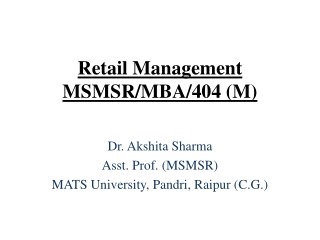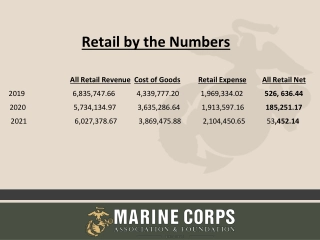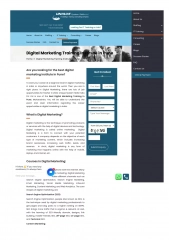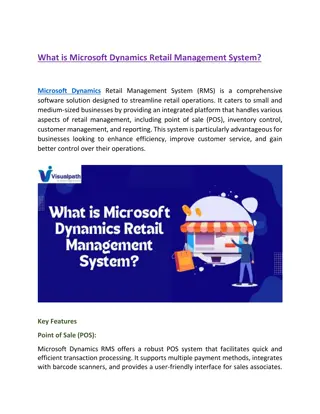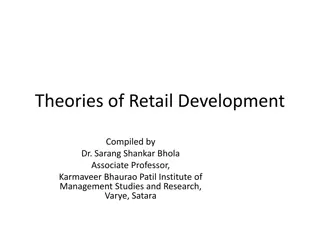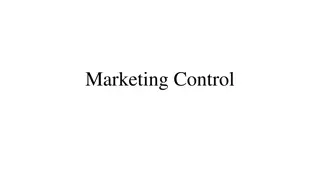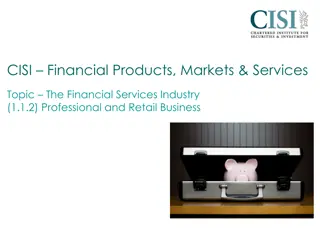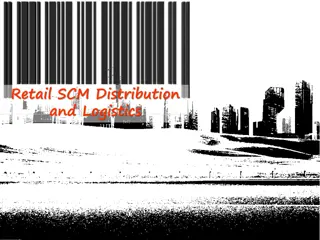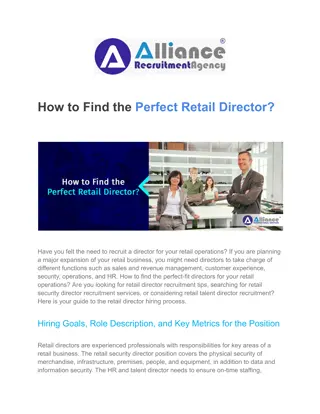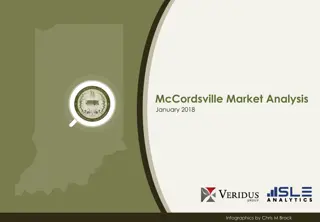Essential Steps for Successful Marketing Implementation in Retail Business
Establishing the right expectations, building a capable team with necessary resources, effective communication of the plan, and creating a detailed timeline are crucial for successful marketing implementation in the retail business. Marketing efforts require time and effort before yielding results, therefore setting realistic expectations upfront is key. Building a competent team, securing essential resources, and clear communication are vital for executing marketing strategies effectively. Additionally, outlining a detailed timeline with manageable tasks and utilizing project management tools can streamline the implementation process.
Download Presentation

Please find below an Image/Link to download the presentation.
The content on the website is provided AS IS for your information and personal use only. It may not be sold, licensed, or shared on other websites without obtaining consent from the author. Download presentation by click this link. If you encounter any issues during the download, it is possible that the publisher has removed the file from their server.
E N D
Presentation Transcript
Unit-3 Managing the Retail Business
o Contents: Contents:- - Implementing Retail Marketing Plan Human Resource Requirements Developing Product and Branding Strategies Developing Merchandise Plans Merchandising Strategy
1. Set the right expectations. It s important to remember that marketing is not a quick fix. If you want your marketing efforts to be successful, it s important to remember that this is a marathon, not a sprint. We often tell companies that it takes 6-12 months before you start to see the return on your marketing efforts. Think of it like rolling a snowball down a hill. The snowball is small at first and it takes a lot of work to get it started. But, once you get going, the momentum builds and it gets a lot easier for it to grow. Marketing works much the same way. It will take some time and effort to build the right foundation for your efforts. Once you do, you ll start to see the momentum you re looking for in your business. Because marketing success takes time, it s important to make sure your company leadership and team understands that. Setting those expectations up front will help everyone understand
2. Build the team and secure resources. Who will be on your marketing implementation team? It s important to think through who you will need to help with this effort. Sometimes, that will include employees at your company such as members of your marketing department (if you have one), sales team or customer service department. Other times, that means bringing in an outsourced marketing partner or a number of vendors to help you. Either way, make sure you know who needs to be on your team to implement the effort. Also, look at what other resources you need. Are there tools, materials or education that you need to get started? If so, make sure you get those resources in place too.
3. Communicate the plan. Once you have built your marketing team, be sure to communicate the marketing strategy to this group and help them understand the goals. Make sure each member of your marketing team understands the role they plan in the implementation effort and how they will contribute to your success. In addition to communicating the plan to your core team, you should also give the rest of your company an overview of your efforts. This will help create excitement about your efforts and make your entire organization feel they are part of what is happening. 4. Build out timeline and tasks. If your marketing strategy didn t include a detailed project timeline, now is the time to build one. It makes sense to take each project and break it up into smaller tasks and deadlines to make the effort manageable for your team.
Also, it helps to work backwards from when you want to launch an effort. So, for instance, if you want to launch a new website in May, work backward to see what needs to happen to deliver on that. When you re setting this up, it can be helpful to use project management software. This will allow you to easily assign tasks and deadlines to team members, while also keeping everyone on the same page. Our team usesAsana and we LOVE it! It s fantastic free tool that cuts down on email and makes it easy for us to stay on top of our projects. However, there are plenty of other options out there, such as Basecamp and Trello
5. Set up a dashboard for tracking success. You can t manage what you don t measure. That s why it s important to set up the proper tracking tools to measure your efforts. Your measurement dashboard should be a template that you can easily update with key metrics throughout your campaigns. What gets measured will be different for every company based on your goals and marketing strategy. However, make sure to tie your metrics to the overall business objectives for your marketing efforts. So, for instance, if your company wants to increase revenue by 25% this year, make sure your efforts are tracking the number of leads and sales generated from your efforts. You should also track the key performance indicators (KPIs) for those metrics, which are things that could impact those top line results. These KPIs could include things like email sign ups, eBook downloads, webinar participation, etc.
6. Monitor and check-in regularly. Once you ve built that measurement dashboard, it should be easy for you to plug in the necessary information along the way. Doing this will help you easily gauge the temperature of your marketing efforts. At the very least, you should do a monthly check-in of your results so you can see what is working and what isn t. For larger efforts, it makes sense to do this on a weekly basis. As part of your regular monitoring effort, you should also meet with your team regularly to go over the progress. This helps everyone understand how things are going and what needs to be done to reach your goals.
Requirements Human Resource concern the specific capabilities or attributes needed by the people who perform the work of the project. For example, on a custom software development project, having at least one person with the ability to develop software is a human resource requirement. The ability to develop software is the skill that s required to complete the work of the project. It might also be a human resource requirement to have someone on the project team with a specific certification. Consider a construction project where certain work activities must be performed by a certified electrician. The human resources requirements of a legal project might involve someone with both a degree and a license. Another requirement might concern their availability.
Developing right product strategy has always been at the centre of the retail business . Since ages retailers, traders and merchants have always worked towards offering quality products to its customers. The most fundamental role of the retailer has been to distribute and sell products to its customers. However during the twentieth century retailers were typically seen as stockist of a particular range of manufacturer s product. Liberalization, Globalization, Privatization and Digitalization has significantly changed the role of retailers from being a passive distributor to an active intermediary who controls the product range offering by carefully selecting products from the manufacturer. Retail product strategy is not just about making sure that the best product offering (goods & services) is available in the store but also ensures that how well the customers are persuaded and attracted towards the product offering.
Brand building Strategy in Retailing: Brand -the concept has become a buzz word today. From the toothpaste that we use, to the shampoo that we apply, the coffee that we drink and the shopping mall that we visit to buy stuff, every product is distinguished on the basis of a name-a Brand Name. Colgate toothpaste, Dove shampoo, Nescafe coffee and Central Mall every product today is identified through a brand name. The two major elements that define the concept of Brand are: first-the Brand gives identification to the product and second is Brand enables customers identify the source of ownership. A Book titled Principles of Marketing co-authored by Dr. Philip Kotler and Gary Armstrong defines the concept of Brand as, name, term, sign, symbol. (or a combination of these) that identifies the maker or seller of the product . Brands have become an Integral part of customer s life. Strong Brand enhances the Goodwill and Value of the product. It is a valuable asset for the retail firms which can be traded. Retailers continuously work towards building strong store brands.
Brand Building: Brand Building is a systematic and continuous process of creating value for customers. Brand building is all about creating customer awareness for the brand, offering tangible and intangible benefits through a brand, engaging customers with the brand and providing unique and seamless brand experience. Retail firms usually concentrate on developing store brands that creates a place for itself in the minds of the customers. In case of retail business, the retailer work towards creating and building store brands this automatically create a demand for the product that it sells.
The retailers usually follows certain step by step process in brand building strategy, which is explained below: 1. Defining a Store Brand: Every retail store has its own separate identity and is established with certain aims. There may be retail store/outlet that aims to offer premium and luxury watches to the segment that belongs to or aspire for a luxury lifestyle. Another retail store may deal in kids clothing and accessories and target only infant and toddlers. Hence every retail store has its own personality and identity which is to be defined and well communicated with the target audience. The fundamental role of a brand is to differentiate itself from its competitors and built a unique personality for itself. The brand should also reflect the core values of the company and the vision on which the company is build. An effective branding strategy begins with defining a brand and what it stands for. The brand must reflect who you are, who you want to be, and how you want to be perceived by the potential customers.
2. Positioning and differentiating the store Brand: A brand strategy is build around a sound positioning and differentiation strategy. Brand Positioning in retailing is all about creating a positive and favorable image of a store in the minds of the customers. At this stage the retailers work towards creating brand association in customers mind to make them perceive the brand in a specific way. 3. Presenting Brand knowledge to the target customers: Customers before taking a buying decision wants to know everything about the brand that they are planning to experience. Be it a product, services or a store, customers want to know the value that the brand will be going to offer them. This stage focuses on developing ways in which the brand is presented to the target customers. Retailers use various media platform to communicate the real meaning and the essence of the brand. Innovative and creative ways are used by the retail marketers to reach the target customers. Taglines, Slogans, logos are various ways in which the brand is communicated to the target customers.
4. offering Personalized Brand Experience: Personalization refers to offering one-to-one shopping experience to the customers. Today customers are well educated, informed and much brand conscious. They have huge expectations from the brand that they trust. Stores that provide personalized shopping experience are much appreciated and accepted by the customers. Data Analytics is used by the retailers to gather relevant data of its customers, such as the location, browsing history, gender, buying preferences and usage. This data is further sorted and specific information of the customer is used to develop various personalized promotion messages and product offerings. Retailers set up notifications to inform and remind customers about the various new product arrivals and upcoming offers. Many retailers also celebrate customer s birthday with customized discount, gifts and membership points. By tracking the buying history retail marketers can also provide personalized buying recommendation to its customers. However Personalization of brands has become a necessity survive and thrive in an era of empowered customers.
5. Performance evaluation of the Brand: Brand is not a static entity. They change in their nature, in their value, in their worth and in their personality depending upon the dynamic market environment, competitors strategy, customer preferences and buying behaviors. Every brand has a life cycle that it goes through and experiences various lows and highs in the business journey. During this journey the retailer needs to know how is the brand performing in the market, how satisfied are the customers with the store brand that they buy from, and where exactly the brand stands in the market. Measuring the performance of the brand will help retailers design future business and brand strategy. The above steps can help retailers focus on building brand and brand strategy in order to create, communicate and deliver superior value to the customers and in return capture value from the customers through achieving customer loyalty.
Objectives and Summary 1. To demonstrate the importance of a sound merchandising philosophy Developing and implementing a merchandise plan is a key element in a successful retail strategy. Merchandising consists of the activities involved in a retailer s buying goods and services and making them available for sale. A merchandising philosophy sets the guiding principles for all merchandise decisions and must reflect the desires of the target market, the retailer s institutional type, its positioning, its defined value chain, supplier capabilities, costs, competitors, product trends, and other factors. 2. To study various buying organization formats and the processes they use The buying organization and its processes must be defined in terms of the level of formality, degree of centralization, organizational breadth, personnel resources, functions performed, and staffing.
With a formal buying organization, merchandising is a distinct retail task in a separate department. In an informal buying organization, the same personnel handle both merchandising (buying) and other retail tasks. Multi-unit retailers must choose whether to have a centralized or a decentralized buying organization. In a centralized organization, all purchases emanate from one office. In a decentralized organization, decisions are made locally or regionally. For a general organization, one person or a few people buy all merchandise. For a specialized organization, each buyer is responsible for a product category. An inside buying organization is staffed by a retailer s personnel and decisions are made by its permanent employees. An outside buying organization involves a company or personnel external to the retailer.
Most retailers use either an inside or an outside buying organization; some employ a combination. A resident buying office, which can be an inside or outside organization, is used when a retailer wants to keep in close touch with key markets and cannot do so through headquarters buying staff. Independents and small chains often use cooperative buying to compete with large chains. If a retailer has a merchandising view, merchandise personnel oversee all buying and selling functions. If it has a buying view, merchandise personnel oversee buying, advertising, and pricing, while store personnel oversee assortments, displays, personnel deployment, and sales presentations. A buyer is responsible for selecting merchandise and setting a strategy to market that merchandise. He or she devises and controls sales and profit projections for a product category; plans assortments, styling, sizes, and quantities; negotiates with and evaluates vendors; and oversees store displays. A sales manager oversees the on-floor selling and operational activities for a specific retail department. He or she must be a good organizer, administrator, and motivator.
3. To outline the considerations in devising merchandise plans: forecasts, innovativeness, assortment, brands, timing, and allocation Forecasts are projections of expected retail sales and form the foundation of merchandise plans. Staple merchandise consists of the regular products a retailer carries. A basic stock list specifies the inventory level, color, brand, and so on for every staple item carried. Assortment merchandise consists of products for which there must be a variety so customers have a proper selection. A model stock plan projects specific assortment merchandise. Fashion merchandise has cyclical sales due to changing tastes and lifestyles. Seasonal merchandise sells well over non consecutive periods. With fad merchandise, sales are high for a short time. In forecasting for best- sellers, many retailers use a never-out list.
A retailers innovativeness is related to the target market(s), product growth potential, fashion trends, the retailer s image, competition, customer segments, responsiveness to consumers, investment costs, profitability, risk, constrained decision making, and declining goods and services. Three issues are of particular interest: How fast will a new good or service generate sales? What are the most sales to be achieved in a season or a year? Over what period will a good or service continue to sell? A useful tool is the product life cycle. An assortment is the selection of merchandise a retailer carried. The retailer first chooses the quality of merchandise. The assortment is then determined. Width of assortment refers to the number of distinct product categories carried. Depth of assortment refers to the variety in any one category. As part of assortment planning, a retailer chooses its mix of brands. Manufacturer brands are produced and controlled by manufacturers. Private brands contain names designated by wholesalers or retailers. Generic brands feature generic names as brands and are a form of private brand.
4. To discuss category management and merchandising software Category management is a technique for managing a retail business that focuses on product category results rather than the performance of individual brands. It arranges product groups into strategic business units to better address consumer needs and meet financial goals. Category management helps retail personnel make the merchandising decisions that maximize the total return on the assets. There is now plentiful PC- and Web-based merchandising software available for retailers, in just about every aspect of merchandise planning.
Retail Merchandising In the retail sector, merchandise is a classification professionals use to categorize the industry by the types of goods and services offered (e.g., automotive parts, shoes, jewellery, etc.). Merchandising is both an activity and a strategy that contributes to the sale of goods and services by stimulating interest or otherwise enticing customers to make a purchase (examples include promotional deals and discounting methods). Retail merchandising includes activities and strategies such as in-store design, the selection of specific merchandise to match a target market, and the physical and digital marketing of merchandise to customers. As a form of marketing, promotional merchandising includes programs such as attractive promotional displays featuring recognizable adult celebrities or licensing agreements between retailers and entertainment companies that utilize identifiable animated children s movie characters.
The goal of retail merchandising activity is to support a retail strategy that generates revenue for the retailer and value for the customer. The selection of retail merchandise and the type of goods and services a retailer decides to stock are key retail strategies. According to author Michael Levy in Retailing Management, the decision to carry particular merchandise is tactical rather than strategic. Merchandise management, along with store management principles, are the "tactical decisions" that Levy believes help implement retail strategy. For example, Lululemon uses attractive packaging to market its apparel. Lululemon provides customers with reusable bags in a variety of sizes and styles. The bags leave the retail store and serve as a type of moving merchandising strategy for brand awareness. The packaging is so effective and recognizable among the brand s loyalists that there is a resale market on ebay for the bags.
Merchandising Strategy Merchandising strategy involves the tactics (or business processes) that contribute to the sale of goods and services to the customer for profit. Tactics within the overall retail strategy include the variety of merchandise available for sale in store or online and how the retailer advertises and displays that merchandise to stimulate interest and create a customer experience. A sound retail strategy involves developing a desirable retail merchandise mix of products that add unique customer value.
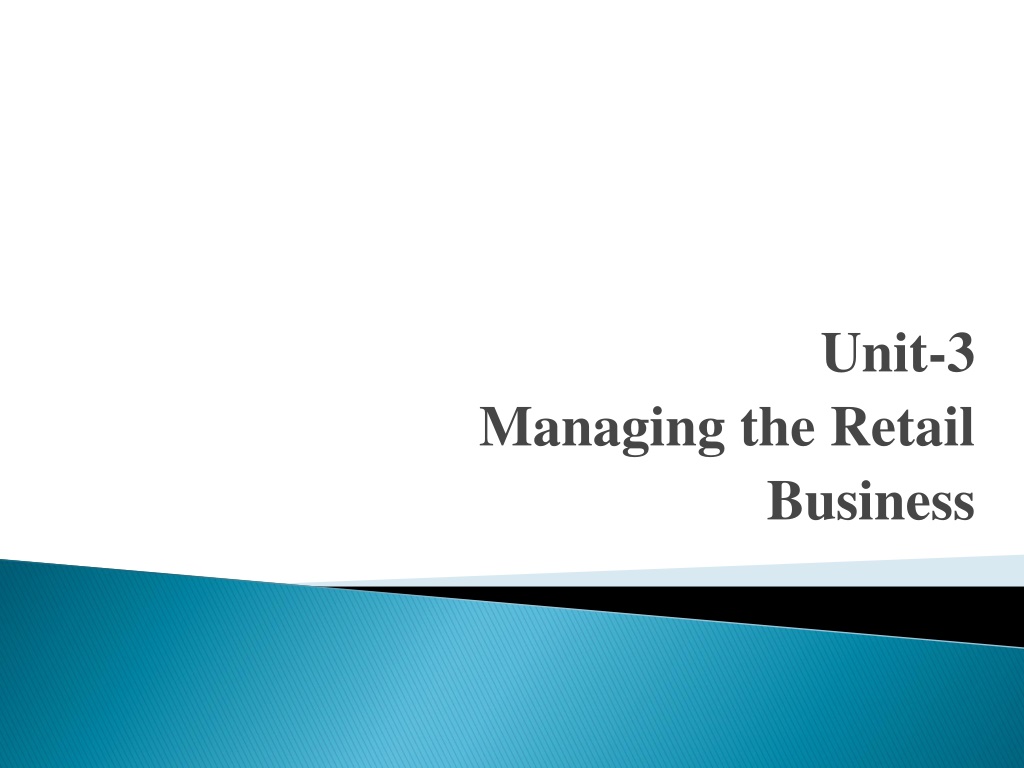
 undefined
undefined







